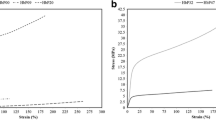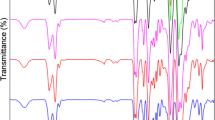Abstract
Two series of 4, 4′-diphenylmethane diisocyanate (MDI) type polyurethanes based on poly(tetramethyleneoxide) glycol (PTMO) and polybutylene adipate glycol (PBA) as soft segments were synthesized by one-step bulk polymerization process. Various hard segments were obtained from hydroquinone ether derivatives with or without ether oxygen structure bonded with the aromatic units in main chain, including hydroquinone (HQE), hydroquinone bis(b-hydroxyethy) ether (HQEE), and 4-hydroxyethyl ethyl oxygen-1-hydroxy ethyl benzene ether (HQEE-L) as chain extenders. The effect of chain extender structure on aggregation structure, thermal and mechanical properties was studied. ATR-FTIR suggested that hydrogen bonding interactions were significantly changed in the presence of flexible ether oxygen structure in hard segment. HQEE-based polyurethanes and HQEE-L-based polyurethanes displayed microphase separation and microphase mixing behavior respectively based on DMA and DSC results. XRD curves confirmed that flexible ether oxygen chain bonded with the rigid aromatic units played a balancing role in the steric effect caused by aromatic chain extender. Thermal properties of polyurethanes were affected mainly by the hard segment packing while mechanical properties were influenced by both phase separation and phase mixing which possess strong hydrogen bonding interactions. The excellent elongation in PTMO/HQEE-L and the high ultimate tensile strength in PBA/HQEE-L can be attributed to the phase mixing with strong hydrogen bonding interactions presented in HQEE-L-based polyurethanes.









Similar content being viewed by others
References
Koerner H, Kelley JJ, Vaia RA (2008) Transient microstructure of low hard segment thermoplastic polyurethane under uniaxial deformation. Macromolecules 41:4709–4716
Velankar S, Cooper SL (2000) Microphase separation and rheological properties of polyurethane melts. 2. Effect of block incompatibility on the microstructure. Macromolecules 33:382–394
Bagdi K, Molnár K, Kállay M, Schön P, Vancsó JG, Pukánszky B (2012) Quantitative estimation of the strength of specific interactions in polyurethane elastomers, and their effect on structure and properties. Eur Polym J 48:1854–1865
Lopes RVV, Loureiro NPD, Pezzin APT, Gomes ACM, Resck IS, Sales MJA (2013) Synthesis of polyols and polyurethanes from vegetable oils-kinetic and characterization. J Polym Res 20:238–246
Chen S, Wang Q, Wang T (2012) Preparation, tensile, damping and thermal properties of polyurethanes based on various structural polymer polyols: effects of composition and isocyanate index. J Polym Res 19:9994–10000
Klinedinst DB, Yilgör E, Yilgör I, Beyer FL, Wilkes GL (2005) Structure-property behavior of segmented polyurethaneurea copolymers based on an ethylene-butylene soft segment. Polymer 46:10191–10201
Yanagihara Y, Osaka N, Murayama S, Saito H (2013) Thermal annealing behavior and structure development of crystalline hard-segment domain in a melt-quenched thermoplastic polyurethane. Polymer 54:2183–2189
Liu X, Cheng J, Zhang J (2014) Preparation of thermal plastic polyurethane-polystyrene block copolymer via UV irradiation polymerization. J Polym Res 21:544–551
Rueda-Larraz L, D’Arlas BF, Tercjak A, Ribes A, Mondragon I, Eceiza A (2009) Synthesis and microstructure–mechanical property relationships of segmented polyurethanes based on a PCL-PTHF-PCL block copolymer as soft segment. Eur Polym J 45:2096–2109
Xu Y, Petrovic Z, Das S, Wilkes GL (2008) Morphology and properties of thermoplastic polyurethanes with dangling chains in ricinoleate-based soft segments. Polymer 49:4248–4258
Oprea S (2012) Novel quinoline-based polyurethane elastomers. The effect of the hard segment structure in properties enhancement. J Polym Res 19:1–9
Kojio K, Nakashima S, Furukawa M (2007) Microphase-separated structure and mechanical properties of norbornane diisocyanate-based polyurethanes. Polymer 48:997–1004
He Y, Zhang X, Runt J (2014) The role of diisocyanate structure on microphase separation of solution polymerized polyureas. Polymer 55:906–913
Oprea S (2011) Molecular dynamics, thermo-mechanical and optical studies on benzidine chain extended polyurethane-urea. J Polym Res 18:1777–1785
Miller JA, Lin SB, Hwang KK, Wu KS, Gibson PE, Cooper SL (1985) Properties of polyether-polyurethane block copolymers: effects of hard segment length distribution. Macromolecules 18:32–44
Kuo M, Jeng R, Su W, Dai SA (2008) Iterative synthesis of extenders of uniform chain lengths for making thermo-reversible polyurethane supramolecules. Macromolecules 41:682–690
Korley LTJ, Pate BD, Thomas EL, Hammond PT (2006) Effect of the degree of soft and hard segment ordering on the morphology and mechanical behavior of semicrystalline segmented polyurethanes. Polymer 47:3073–3082
Yoon SC, Ratner BD (1988) Surface and bulk structure of segmented poly (ether urethanes) with perfluoro chain extenders. 2. FTIR, DSC, and X-ray photoelectron spectroscopic studies. Macromolecules 21:2392–2400
Sheikhy H, Shahidzadeh M, Ramezanzadeh B, Noroozi F (2013) Studying the effects of chain extenders chemical structures on the adhesion and mechanical properties of a polyurethane adhesive. J Ind Eng Chem 19:1949–1955
Oprea S (2010) The effect of chain extenders structure on properties of new polyurethane elastomers. Polym Bull 65:753–766
Mishra AK, Narayan R, Raju K, Aminabhavi TM (2012) Hyperbranched polyurethane (HBPU)-urea and HBPU-imide coatings: effect of chain extender and NCO/OH ratio on their properties. Prog Org Coat 74:134–141
Vlad S (2008) Influence of the chain extender length and diisocyanate amount on the thermal stability and mechanical properties of some polyurethanes. Mater Plast 45:394–397
Tatai L, Moore TG, Adhikari R, Malherbe F, Jayasekara R, Griffiths I, Gunatillake PA (2007) Thermoplastic biodegradable polyurethanes: the effect of chain extender structure on properties and in-vitro degradation. Biomaterial 28:5407–5417
Orgilés-Calpena E, Arán-Aís F, Torró-Palau AM, Orgilés-Barceló C (2012) Influence of the chain extender nature on adhesives properties of polyurethane dispersions. J Disper Sci Technol 33:147–154
Tong SN, Tsai SR, Lii JS, Wu P (1987) Aromatic diols as chain extender in PU reaction molding. J Elastom Plast 19:188–203
Zha L, Wu M, Yang J (1999) Hydrogen bonding and morphological structure of segmented polyurethanes based on hydroquinone-bis (β-hydroxyethy) ether as a chain extender. J Appl Polym Sci 73:2895–2902
Chang Z, Zhang M, Hudson AG, Orler EB, Moore RB, Wilkes GL, Turner SR (2013) Synthesis and properties of segmented polyurethanes with triptycene units in the hard segment. Polymer 54:6910–6917
Barikani M, Fazeli N, Barikani M (2013) Study on thermal properties of polyurethane-urea elastomers prepared with different dianiline chain extenders. J Polym Eng 33:87–94
Rogulska M, Kultys A, Podkościelny W (2007) Studies on thermoplastic polyurethanes based on new diphenylethane-derivative diols. II. Synthesis and characterization of segmented polyurethanes from HDI and MDI. Eur Polym J 43:1402–1414
Kultys A, Rogulska M, Głuchowska H (2011) The effect of soft-segment structure on the properties of novel thermoplastic polyurethane elastomers based on an unconventional chain extender. Polym Int 60:652–659
Cakić SM, Ristić IS, Krakovský I, Stojiljković DT, Bělský P, Kollová L (2014) Crystallization and thermal properties in waterborne polyurethane elastomers: influence of mixed soft segment block. Mater Chem Phys 144:31–40
Mishra AK, Chattopadhyay DK, Sreedhar B, Raju K (2006) FT-IR and XPS studies of polyurethane-urea-imide coatings. Prog Org Coat 55:231–243
Kumari S, Mishra AK, Krishna A, Raju K (2007) Organically modified montmorillonite hyperbranched polyurethane-urea hybrid composites. Prog Org Coat 60:54–62
Walo M, Przybytniak G, Łyczko K, Piątek-Hnat M (2014) The effect of hard/soft segment composition on radiation stability of poly (ester-urethane) s. Radia Phys Chem 94:18–21
Chattopadhyay DK, Mishra AK, Sreedhar B, Raju K (2006) Thermal and viscoelastic properties of polyurethane-imide/clay hybrid coatings. Polym Degrad Stabil 91:1837–1849
Wen T, Wu M, Yang C (1999) Spectroscopic investigations of poly (oxypropylene) glycol-based waterborne polyurethane doped with lithium perchlorate. Macromolecules 32:2712–2720
Lee HS, Wang YK, Hsu SL (1987) Spectroscopic analysis of phase separation behavior of model polyurethanes. Macromolecules 20:2089–2095
Xu K, Zhang F, Zhang X, Hu Q, Wu H, Guo S (2014) Molecular insights into hydrogen bonds in polyurethane/hindered phenol hybrids: evolution and relationship with damping properties. J Mater Chem A 2:8545–8556
Saralegi A, Rueda L, Fernández D’Arlas B, Mondragon I, Eceiza A, Corcuera MA (2013) Thermoplastic polyurethanes from renewable resources: effect of soft segment chemical structure and molecular weight on morphology and final properties. Polym Int 62:106–115
Zhang Y, Xia Z, Huang H, Chen H (2009) Thermal degradation of polyurethane based on IPDI. J Anal Appl Pyrol 84:89–94
Chattopadhyay DK, Webster DC (2009) Thermal stability and flame retardancy of polyurethanes. Prog Polym Sci 34:1068–1133
Kulkarni P, Ojha U, Wei X, Gurung N, Seethamraju K, Faust R (2013) Thermal and mechanical properties of polyisobutylene‐based thermoplastic polyurethanes. J Appl Polym Sci 130:891–897
Zhang C, Hu J, Wu Y (2014) Theoretical studies on hydrogen-bonding interactions in hard segments of shape memory polyurethane-III: isophorone diisocyanate. J Mol Struct 1072:13–19
Acknowledgments
The authors greatly appreciated the financial support granted by the National Natural Science Foundation of China (Project No.21176017).
Author information
Authors and Affiliations
Corresponding authors
Rights and permissions
About this article
Cite this article
Liu, X., Wang, T., Li, J. et al. Synthesis and properties of segmented polyurethanes with hydroquinone ether derivatives as chain extender. J Polym Res 22, 149 (2015). https://doi.org/10.1007/s10965-015-0792-5
Received:
Accepted:
Published:
DOI: https://doi.org/10.1007/s10965-015-0792-5




